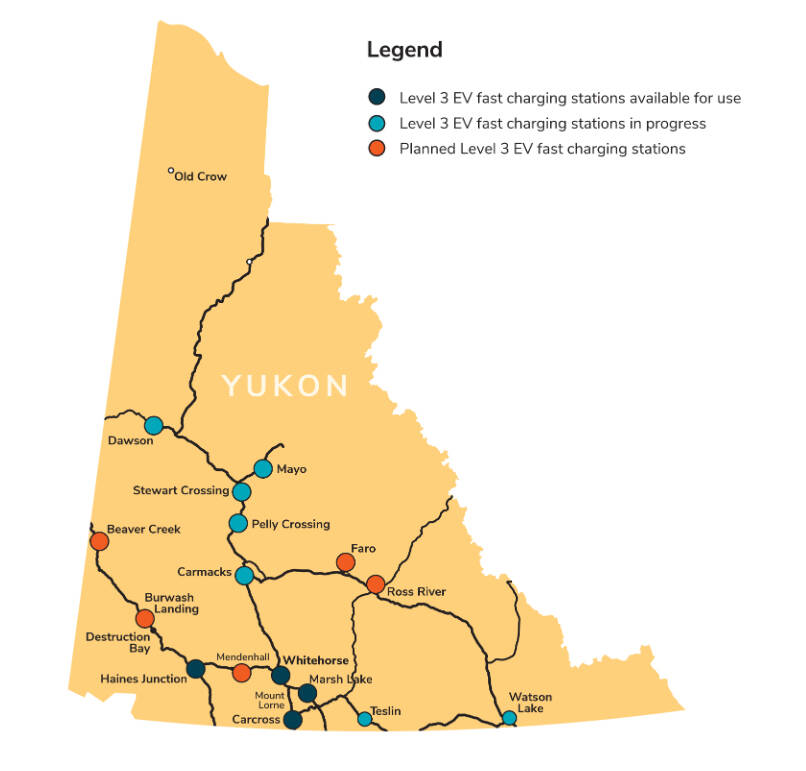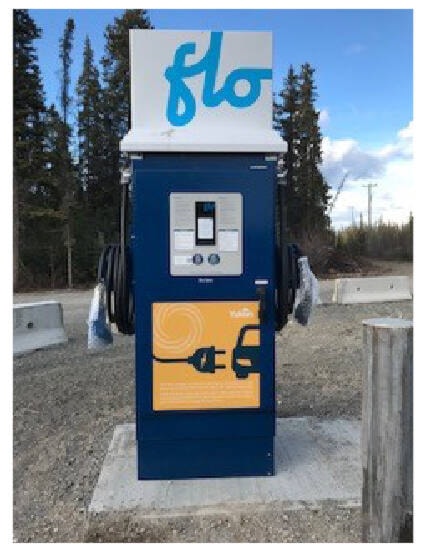There may not yet be any electric vehicle charging stations along the Dempster Highway, but thanks to an ongoing greenhouse gas emission project by the Yukon government, they’re getting closer.
Just over two years after a small delegation presented the Yukon’s vision for the northwestern road network in Inuvik, talks between the Northwest Territories, Alaskan and British Columbian government are underway to determine how to best operate the grid, though Energy Branch acting director of operations Matthew Ooms noted it would likely be a few years before a final agreement is hammered out.
“Our first priority is to focus on ensuring all of the Yukon’s communities are accessible by electric vehicle,” he said. “We are actively implementing this plan and anticipate we’ll complete this initiative in 2023, well in advance of our target date of March 2027.
“When we were developing our strategy to meet the challenges posed by climate change, the Government of Yukon held two rounds of public engagements across the Yukon and hosted public information sessions including in cross-border Arctic communities located in the Northwest Territories. These public sessions were held in 2018 and again in 2019. From those discussions, we finalized and announced our strategy in September 2020.”
Called ‘Our Clean Future’, the plan calls for the installation of fast EV charging stations across the Yukon and beyond and will also include a regulatory framework for private businesses to sell electricity to vehicles. Incentive and rebate programs are also being set up for property owners and organizations to install chargers at their buildings.
To date, the Yukon has installed five fast chargers and two slightly slower chargers. The fast chargers can fully power an EV within an hour or two while the slower chargers are more for overnight stops. Stations have been installed in Whitehorse and several other southern Yukon communities, with seven more expected to come into operation, the northernmost in Dawson City. Another six are currently being planned.
From there, the plan is to move up the Dempster towards Eagle Plains and then beyond.
“Once this initiative is complete, we anticipate that there will be a public fast charger both within a community and within 100 kilometers from any of Yukon’s road connected communities,” said Ooms, who noted colder climates presented a few logistic challenges but nothing foreboding. “Cold temperatures do pose some challenges to installing electric vehicle charging stations, but nothing too different from typical construction or electrical projects in the territory.
“Working outdoors, adapting to unpredictable weather, and arranging travel for crews becomes more challenging and expensive as the weather becomes colder. Earthworks such as trenching for new cables and wiring also becomes more challenging as the ground freezes. The fast chargers that the Government of Yukon has procured are rated to operate down to minus 40 Celsius, though drivers can expect the charging cables to become stiffer and the charging speed to be slower as the temperature reaches these extremes.”
Electrification of Canada’s roadways is seen as essential for widespread decarbonization of the transport sector, which is one of the larger greenhouse gas emitters in Canada. The Yukon estimates 54 per cent of GHGs come from its transportation sector, including through traffic coming further north to the Beaufort Delta.
A few electric vehicles are in use in Yellowknife and at least one electric vehicle has already been driven to the Arctic ocean and back. In 2019, California resident George Teepe drove his Tesla up the west coast, through the Yukon and up the Dempster all the way to Arctic Ocean, making use of RV charging stations at campsites and later using high-load plug-ins for laundry as he got further north. However, it showed the technology is capable of handling the terrain.
However, a NWT Infrastructure spokesperson poured cold water on the idea there would be electric chargers coming up the Beaufort Delta anytime soon, noting the lack of a solid power plant in the area was a major factor.
”One of the strategic objectives of the 2030 Energy Strategy is to reduce emissions from transportation by 10 per cent. The Government of the Northwest Territories is currently prioritizing electrifying highways in proximity to renewable energy generation like hydropower and is not actively working on providing electric vehicle (EV) charging stations along the Dempster Highway,” said Darren Campbell. “The GNWT has had conversations with representatives from the Yukon Government regarding EV charging stations along the Dempster Highway. There are factors that make it challenging to establish charging stations in this area.
“The Dempster Highway is 736 kilometres long and has no suitable electricity service to power EV charging stations. This means that providing reliable and safe EV charging stations along the highway is technically challenging and economically prohibitive. The GNWT has application-based grant funding for EV charging infrastructure in the NWT under the Greenhouse Gas Grant Program. To date, no applications have been received related to funding for EV chargers in the NWT for the Dempster Highway.”

